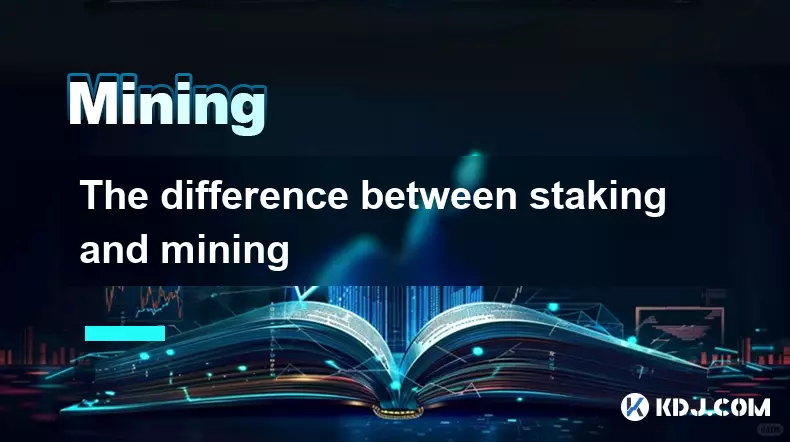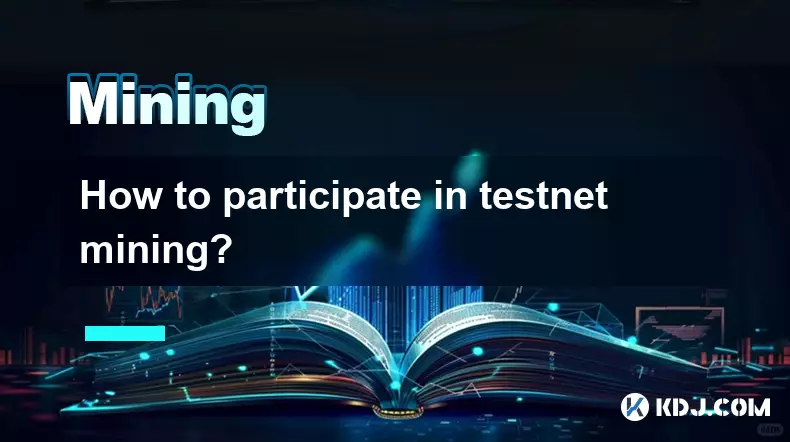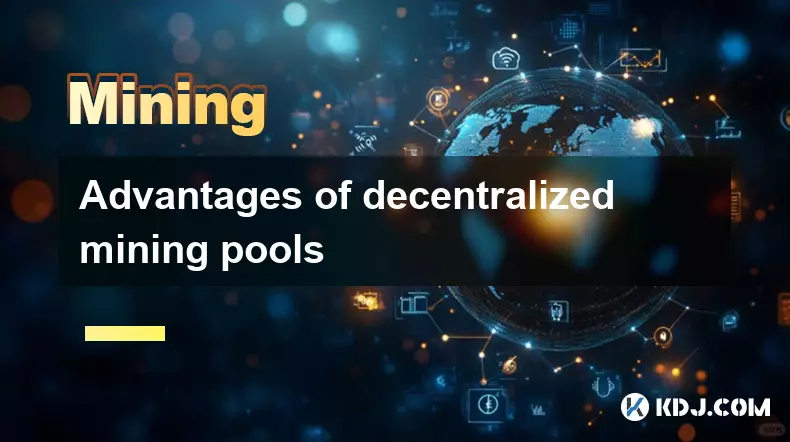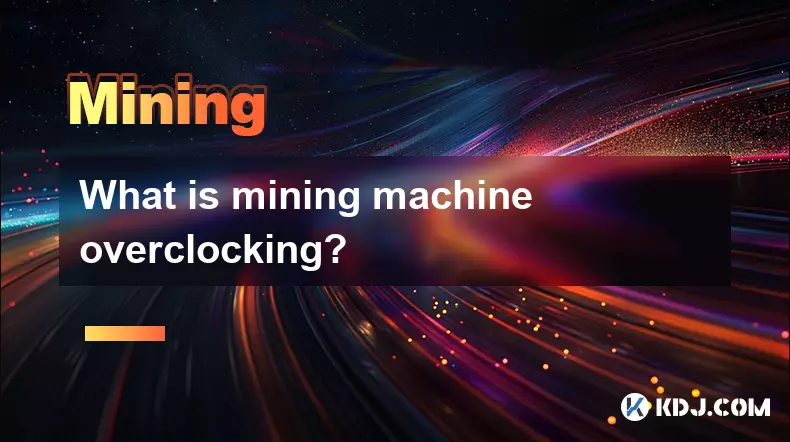-
 bitcoin
bitcoin $114779.865156 USD
2.30% -
 ethereum
ethereum $4226.519789 USD
2.39% -
 tether
tether $1.000545 USD
0.04% -
 xrp
xrp $2.890223 USD
0.92% -
 bnb
bnb $1030.029301 USD
2.95% -
 solana
solana $212.824944 USD
1.69% -
 usd-coin
usd-coin $0.999757 USD
0.01% -
 dogecoin
dogecoin $0.234961 USD
-0.27% -
 tron
tron $0.337174 USD
0.42% -
 cardano
cardano $0.804783 USD
0.09% -
 hyperliquid
hyperliquid $45.748770 USD
-2.85% -
 chainlink
chainlink $21.699170 USD
0.82% -
 ethena-usde
ethena-usde $1.001452 USD
0.08% -
 avalanche
avalanche $30.237800 USD
1.14% -
 stellar
stellar $0.372604 USD
1.52%
What is "proof-of-work" and how does it relate to mining?
Proof-of-work secures blockchains by requiring miners to solve complex puzzles, ensuring network integrity through computational effort and economic incentives.
Aug 07, 2025 at 02:03 pm

Understanding the Concept of Proof-of-Work
Proof-of-work (PoW) is a consensus mechanism used in blockchain networks to validate transactions and secure the network. It requires participants, known as miners, to solve complex mathematical puzzles before they can add a new block of transactions to the blockchain. The term 'proof-of-work' refers to the evidence that computational effort has been expended to solve the puzzle, ensuring that the proposed block is legitimate. This mechanism prevents malicious actors from easily manipulating the blockchain, as altering any block would require redoing the work for that block and all subsequent blocks, which is computationally infeasible.
The mathematical problem in PoW is typically based on cryptographic hashing. Miners must find a hash value that meets a specific criterion—usually one that is below a target threshold. This process is probabilistic and requires numerous attempts, each involving slight changes to the block’s data, particularly through a value called the nonce. The difficulty of the puzzle is dynamically adjusted to maintain a consistent block creation time, such as every 10 minutes in Bitcoin.
The Role of Miners in Proof-of-Work Systems
Miners are the backbone of any PoW blockchain. Their primary function is to collect pending transactions, verify their validity, and package them into a candidate block. Once a block is assembled, the miner begins the process of finding a valid hash. This involves:
- Collecting unconfirmed transactions from the mempool
- Verifying digital signatures and ensuring no double-spending
- Constructing the block header, which includes the previous block’s hash, the Merkle root of transactions, and a timestamp
- Incrementing the nonce repeatedly and hashing the block header using a cryptographic function like SHA-256
Each hash attempt is independent, and success depends on both computational power and luck. The first miner to find a hash that satisfies the network’s difficulty target broadcasts the solution to the network. Other nodes quickly verify the solution and, if valid, add the block to their copy of the blockchain.
How Mining Hardware Evolved for Proof-of-Work
Initially, Bitcoin mining could be performed using standard CPUs. However, as the network grew, the difficulty increased, making CPU mining inefficient. Miners began using Graphics Processing Units (GPUs) because they could perform parallel computations much faster than CPUs. GPUs offered a significant performance boost for hashing operations.
Later, Application-Specific Integrated Circuits (ASICs) were developed specifically for mining cryptocurrencies like Bitcoin. These devices are optimized solely for computing SHA-256 hashes and offer vastly superior performance and energy efficiency compared to general-purpose hardware. The rise of ASICs led to the centralization of mining power in large mining farms, particularly in regions with low electricity costs.
The hardware used directly impacts a miner’s ability to compete. A higher hash rate—measured in hashes per second—increases the probability of solving the puzzle first. Miners often join mining pools to combine their computational resources and share rewards proportionally, reducing the variance in income.
Economic Incentives Behind Proof-of-Work Mining
To encourage participation, PoW blockchains offer financial rewards. When a miner successfully adds a block, they receive two types of compensation:
- A block reward, which is a fixed amount of newly created cryptocurrency (e.g., 6.25 BTC for Bitcoin as of recent halvings)
- Transaction fees paid by users to have their transactions included in the block
These incentives are crucial for maintaining network security. Without rewards, miners would have no motivation to invest in expensive hardware and electricity. The block reward is designed to decrease over time through events like the Bitcoin halving, which occurs approximately every four years, reducing the new supply of coins. This scarcity model mimics precious metals like gold.
The cost of mining includes hardware acquisition, maintenance, and especially electricity consumption. Profitability depends on the current price of the cryptocurrency, the miner’s hash rate, power efficiency, and local electricity rates. Some miners operate in colder climates to reduce cooling costs, while others seek renewable energy sources to lower operational expenses.
Security and Immutability in Proof-of-Work Networks
One of the most significant advantages of PoW is its resistance to attacks. To alter a past block, an attacker would need to re-mine that block and all blocks that follow, requiring more than 50% of the network’s total hash power—a scenario known as a 51% attack. Given the immense computational resources required, such an attack is economically impractical on large networks like Bitcoin.
The decentralized nature of PoW ensures that no single entity controls the blockchain. Each node independently verifies blocks and transactions, rejecting any that do not meet consensus rules. This redundancy enhances trust and transparency.
Moreover, the energy expended in mining serves as a real-world cost that backs the digital ledger. This tangible investment deters fraud and reinforces the permanence of recorded transactions. Every block added increases the cumulative work, making the blockchain increasingly secure over time.
Environmental and Efficiency Considerations
Critics of PoW highlight its high energy consumption. Bitcoin mining alone consumes more electricity annually than some countries. While a portion of this energy comes from renewable sources, the carbon footprint remains a concern. Some miners utilize stranded or excess energy, such as flared natural gas, to improve sustainability.
Efforts to improve efficiency include optimizing cooling systems, upgrading to newer ASIC models with better power-to-performance ratios, and locating operations near hydroelectric or geothermal plants. Despite these measures, the inherent design of PoW requires continuous energy input to maintain security, distinguishing it from alternative consensus mechanisms like proof-of-stake.
FAQs
What happens if two miners find a valid block at the same time?When two miners broadcast a valid block simultaneously, the network temporarily splits into two competing chains. Nodes continue building on whichever block they receive first. Eventually, the chain with more cumulative work (i.e., the longer chain) becomes the accepted version. The other block becomes an orphan block, and its transactions are returned to the mempool for inclusion in future blocks.
Can anyone start mining proof-of-work cryptocurrencies today?Yes, but profitability is a major constraint. Mining Bitcoin with consumer-grade hardware is no longer viable due to competition from ASICs. However, smaller PoW coins that resist ASIC mining—such as those using the RandomX algorithm—can still be mined with CPUs. Success requires careful calculation of electricity costs, hardware efficiency, and expected rewards.
How is the difficulty of proof-of-work adjusted?In Bitcoin, difficulty is recalibrated every 2,016 blocks (approximately every two weeks). The network compares the actual time taken to mine those blocks with the ideal time (20,160 minutes). If blocks were mined too quickly, difficulty increases; if too slowly, it decreases. This ensures a stable block interval regardless of changes in total network hash power.
Why do some blockchains use proof-of-stake instead of proof-of-work?Proof-of-stake (PoS) eliminates the need for energy-intensive mining by selecting validators based on the amount of cryptocurrency they hold and are willing to 'stake' as collateral. PoS aims to achieve the same security as PoW but with significantly lower energy consumption. However, PoW proponents argue that the tangible cost of mining provides stronger economic security guarantees.
Disclaimer:info@kdj.com
The information provided is not trading advice. kdj.com does not assume any responsibility for any investments made based on the information provided in this article. Cryptocurrencies are highly volatile and it is highly recommended that you invest with caution after thorough research!
If you believe that the content used on this website infringes your copyright, please contact us immediately (info@kdj.com) and we will delete it promptly.
- Altcoins Primed for 100x Gains: Cryptocurrencies to Watch
- 2025-09-30 22:45:16
- Debut Auction & XRP ETF Watch: October 18th Auction Set, Crypto's Big Day?
- 2025-09-30 22:45:16
- Navigating Solana Wallets: Your Guide to Secure Crypto in 2025
- 2025-09-30 22:50:11
- BlockchainFX, Crypto & Hyperliquid: Decoding the Future of DeFi in 2025
- 2025-09-30 22:25:13
- Visa's Stablecoin Payout Pilot: Revolutionizing Cross-Border Payments
- 2025-09-30 22:25:13
- Crypto Launchpads: Revolutionizing Blockchain Fundraising for 2025 and Beyond
- 2025-09-30 22:30:13
Related knowledge

The difference between staking and mining
Sep 24,2025 at 05:18am
Understanding Staking in the Cryptocurrency Ecosystem1. Staking involves holding funds in a cryptocurrency wallet to support the operations of a block...

How to participate in testnet mining?
Sep 22,2025 at 09:18am
Understanding Testnet Mining in the Crypto Ecosystem1. Testnet mining is a method used by blockchain developers to simulate real-world conditions on a...

How to dispose of abandoned mining machines?
Sep 19,2025 at 08:19pm
Assessing the Condition of Abandoned Mining Rigs1. Begin by inspecting each mining machine for visible damage, corrosion, or missing components. Machi...

How to identify high-quality mining pools?
Sep 21,2025 at 03:19pm
Reputation and Track Record1. A mining pool’s reputation is built over time through consistent performance and transparency. Pools that have operated ...

Advantages of decentralized mining pools
Sep 20,2025 at 04:36pm
Enhanced Security and Resistance to Censorship1. Decentralized mining pools operate on blockchain-based smart contracts, eliminating the need for a ce...

What is mining machine overclocking?
Sep 21,2025 at 07:19pm
Understanding Mining Machine Overclocking1. Mining machine overclocking refers to the process of increasing the operating frequency of a cryptocurrenc...

The difference between staking and mining
Sep 24,2025 at 05:18am
Understanding Staking in the Cryptocurrency Ecosystem1. Staking involves holding funds in a cryptocurrency wallet to support the operations of a block...

How to participate in testnet mining?
Sep 22,2025 at 09:18am
Understanding Testnet Mining in the Crypto Ecosystem1. Testnet mining is a method used by blockchain developers to simulate real-world conditions on a...

How to dispose of abandoned mining machines?
Sep 19,2025 at 08:19pm
Assessing the Condition of Abandoned Mining Rigs1. Begin by inspecting each mining machine for visible damage, corrosion, or missing components. Machi...

How to identify high-quality mining pools?
Sep 21,2025 at 03:19pm
Reputation and Track Record1. A mining pool’s reputation is built over time through consistent performance and transparency. Pools that have operated ...

Advantages of decentralized mining pools
Sep 20,2025 at 04:36pm
Enhanced Security and Resistance to Censorship1. Decentralized mining pools operate on blockchain-based smart contracts, eliminating the need for a ce...

What is mining machine overclocking?
Sep 21,2025 at 07:19pm
Understanding Mining Machine Overclocking1. Mining machine overclocking refers to the process of increasing the operating frequency of a cryptocurrenc...
See all articles










































































